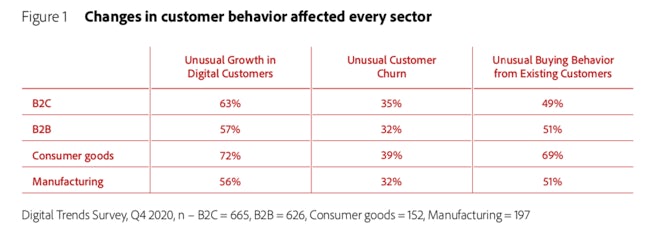Everything changed last year, and the need for digital commerce was immediate. Many in the B2B world scrambled to build digital commerce processes and experiences to support evolving customer demands and revenue requirements. It wasn’t pretty.
Manufacturers were significantly affected by the rapid pivot toward digital channels. Before the pandemic, fewer than 40% of manufacturers, distributors, and B2B organizations had implemented an e-commerce strategy. And only 18% of executives in B2B focused companies agreed that they were “very advanced” regarding their customer experience (CX) maturity.
That’s especially problematic as long sales engagements, complex buying committees, a heavy reliance on face-to-face interactions, and an often complex product range present unique challenges for manufacturing CMOs and CDOs to move online.

However, short-term solutions won’t suffice to drive long-term revenue for brands. Why? According to a recent McKinsey report, 80% of B2B buyers prefer digital self-service over in-person. So, how can B2B brands make meaningful change?
Optimize the digital buyer’s journey
The B2B buying journey has been disjointed due to a deluge of data and the introduction of new digital channels. In fact, 57% of B2B executives reported unusual growth in digital and mobile visitors over the last six months according to the Adobe 2021 Digital Trends Report. To meet your buyer’s expectations and drive conversions, the digital experience needs to change. Make the online experience as close to the in-store experience as possible. Use relevant and accurate product data, pricing information, up-to-date inventory, and delivery timelines to drive engagement.
Leverage your customer data to provide a personalized customer experience with product recommendations and topical content. A PIM solution ensures your product information is accurate and consistent across all channels and powers adaptive merchandizing to give buyers a personalized and relevant experience.
Above all, approach your digital experience with a mobile-first mentality. Roughly 70% of B2B queries are made on a smartphone, and mobile drives 40% of revenue among leading B2B organisations.
Implement interactive content and tools
Visualizations and guided selling tools break down the everyday complexities in the manufacturing and B2B path to purchase. Now with 3D configurators, virtual reality, drawings and diagrams, video tutorials, and technologies available online, buyers can “experience” products just as they would on a showroom or manufacturing floor.
Many top-performing B2B organisations have even taken this a step further. They offer a personalized portal as a way to cut down the content clutter and deliver the right information at the right time in their buying journey. A recent study showed that 86% of B2B buyers felt overwhelmed by content, yet nearly 40% said the content they were served either failed to answer their questions or wasn’t relevant to the purchase they were considering. The good news is that half (45%) believed a personal content portal to be a website must-have.
Evaluate your direct and indirect channel strategies
The majority of B2B organisations do not maintain their e-commerce channel. So there is room for improvement across all direct and indirect channels. Teams should strengthen relationships with distributors and partner channels to build better online capabilities and tie together disjointed channels.
For some B2B teams, expanding their direct sales model is the best way to gain access to key market segments and strategic accounts. For others, leveraging new and existing indirect channels is the best way to enter new markets and reach underserved customer segments. A hybrid approach to channel responsibilities is also an option for manufacturers with the digital capability to handle product promotion, logistics, and other vital tasks.
The path forward
The bottom line is that B2B brands had to turn on a dime to adapt to market realities and changing buyer preferences in 2020. Global lockdowns created an urgency to the digital transformations already underway in visionary organisations. However, many teams are still struggling with where to begin to build digital commerce that will better align with today’s buyers.
Focus on building better buying experiences across channels with the right technologies and processes that scale. Register for the webinar “How B2B Brands Sell Online in 2021”, March 10th, to learn more about how best-in-class B2B organisations are selling today and get the latest data to support the move to digital commerce.


Comments